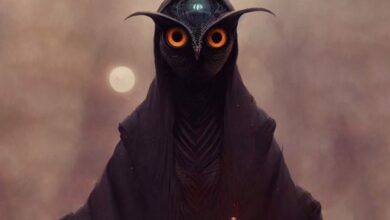Why do people with sleep paralysis see the same “hallucinations”?

 Sleep paralysis is a very frightening condition when a person is on the border of sleep and wakefulness. In medicine, it is called awakening cataplexy.
Sleep paralysis is a very frightening condition when a person is on the border of sleep and wakefulness. In medicine, it is called awakening cataplexy.
Sleep paralysis is a phenomenon that occurs when a person is transitioning between sleep and wakefulness, and experiences a temporary inability to move or speak.
During this state, some people may also have vivid and frightening hallucinations, such as seeing, hearing, or feeling the presence of an intruder, a demon, or an evil entity in their room. These hallucinations are not real, but they can cause intense fear and anxiety for the person experiencing them.
Doctors also believe that a person in this state cannot open their eyes, however, many of those who have experienced nocturnal paralysis were not only with their eyes open, but also saw strange and terrible objects at the same time.
One of the questions that researchers and sleep experts have tried to answer is why do people with sleep paralysis see the same evil “hallucinations”?
Why do they often report similar sensations of being suffocated, choked, or pressed down by a dark figure? What causes these common themes to emerge in different cultures and times?
Most often, people talked about a dark human figure without distinguishable details of the face and clothes, which stands next to the bed or at the feet. This figure in different cultures is called “black man”, “shadow man”, “old hag” and so on.

It is believed that sleep paralysis is a rather rare condition and it is experienced no more than 1-2 times in a lifetime by no more than 7% of the population of our planet.
Most often, for some reason, this happens in adolescents and in people with various mental illnesses. A third of them claim to have experienced sleep paralysis.
Some researchers directly state that it is sleep paralysis that is the cause of stories about alien abductions, night ghosts, and so on.
Doctors, on the other hand, consider the “black man” and other strange creatures that people see with nocturnal paralysis to be simply hallucinations due to the peculiarities of the brain in a state of sleep or drowsiness.
But why do so many different people from different countries and different cultures see such similar “hallucinations”? Why, in general, on the border of sleep and wakefulness, do they suddenly see a HUMAN figure near their bed or on the bed?
Dreams in ancient times were considered a state that connects the earthly world and the other world. For a while, it was even believed that in a dream, a person’s soul could leave his body and go to another world, where he could communicate with the spirits of the dead or even with the Gods, receiving prophecies or useful advice from them.
So maybe the strange figures that a person sees during sleep paralysis are the inhabitants of another world?
Not visible when awake and not tangible when asleep. Someone says that people have the same visions because all our brains as a whole work in the same way and under similar conditions give out the same “picture”.
It may be so, but many people with sleep paralysis do not see only a shadow person, but also some non-humanoid monsters, insects, or do not see anything at all, but hear someone’s terrible laugh or even smell unusual smells. Maybe this is also a feature of the “same work” of the brain?
And why do people see shadow figures, and in general something that brings them to a state of horror, and not something neutral and ordinary, with the “same brain work” in sleep paralysis? Why, for example, do they see a monster that sits on their chest and crushes it, and not a stone?
Or why don’t these people see something good, like angels and God?

There are several possible explanations for this phenomenon, based on scientific, psychological, and cultural factors. Some of the hypotheses are:
– Neurological explanation: Sleep paralysis occurs when the brain is in a mixed state of REM (rapid eye movement) sleep and wakefulness.
REM sleep is the stage of sleep where most dreaming occurs, and it is also associated with muscle atonia, which prevents us from acting out our dreams. However, when we wake up during REM sleep, we may still be partially dreaming, and our brain may project images from our dreams onto our surroundings.
This can create the illusion of seeing or hearing things that are not there. Furthermore, some parts of the brain that are involved in fear processing, such as the amygdala, may be overactive during sleep paralysis, leading to heightened feelings of threat and danger. The brain may also interpret the lack of muscle control and breathing difficulties as signs of being attacked or restrained by an external force.
– Psychological explanation: Sleep paralysis may also be influenced by our expectations, beliefs, and emotions. People who are stressed, anxious, depressed, or have experienced trauma may be more prone to having sleep paralysis and negative hallucinations.
They may also have more negative interpretations of their experiences, such as believing that they are being haunted by evil spirits or cursed by witchcraft. These beliefs may be shaped by their personal history, cultural background, or religious views.
For example, some people may associate sleep paralysis with folklore stories of vampires, succubi, incubi, or night hags. These stories may provide a way for people to make sense of their experiences and cope with their fear.
– Cultural explanation: Sleep paralysis may also reflect some universal aspects of human psychology and culture.
Some researchers have suggested that sleep paralysis hallucinations are influenced by archetypes, which are symbols or patterns that are shared by all humans across different cultures and times.
These archetypes may represent our deepest fears, desires, or conflicts, and they may manifest in different forms depending on the context.
For example, some people may see a dark figure or a shadowy presence as a representation of death, evil, or the unknown. Others may see an animal or a monster as a representation of aggression, violence, or chaos. These archetypes may tap into our primal instincts and emotions, and create a powerful impression on our consciousness.
Sleep paralysis is a complex phenomenon that can have multiple causes and interpretations. It is not a sign of mental illness or supernatural influence, but rather a natural occurrence that can happen to anyone under certain conditions.
However, it can be very distressing and scary for those who experience it, especially if they do not understand what is happening to them or how to prevent it. Therefore, it is important to educate people about sleep paralysis and provide them with effective coping strategies and support.
Greetings, explorer! We thank our supporters from the bottom of our hearts for their generous donations that keep anomalien.com alive. If you’d like to join the cause and help us continue to deliver amazing articles, please consider making a donation. Let’s keep the 👽 smiling!Follow us on Instagram, Twitter and Telegram for interesting and mysterious bonus content!




